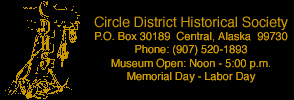
Grip Collection 1-50 Index
THE BILL GRIP COLLECTION
Written by Patricia Oakes - September 1986.
The Bill Grip photo collection adds to the Circle District Museum archives a wide and varied picture of life at the Berry Dredge Camp in the 1930s. Grip, a young man from Duluth, Minnesota, arrived in the Circle District in 1936 and worked summers for the Berry Dredge through 1941. Durlng several of the winters, he was a woodcutter at Birch Hill near Central cutting wood for the dredge. He also spent a winter takirng out a dump near Happy Station, Ester, Alaska, working with Leonard Sepalla. He left Alaska at the end of the 1941 season and settled in Tacoma,Washington, where his varied activities have kept him in touch with Alaska. He is chairman of the Buffelin Wood Products Corporation, which makes custom plywood and doors.
In 1982, Grip returned to the Circle District on a brief trip. He left a collection of negatives which museum photographer, Al Cook, used to make a set of archival prints. In the summer of 1985, Grip and his wife, Gertie, spent a week in the Circle District. On this trip, he documented the photo collectlon on audio cassettes. These cassettes were transcribed by LaVelle Montgomery and Florence Oakes and have been edited by Patricia Oakes for the cutlines for the photos in the collection. (The cassettes are in the CDHS tape collection.)
In preparing the cutlines, the editor has often edited the somewhat lengthy explanations. Where Grip's original wording is used, it is shown in quotation marks. Editor's notes are in parentheses.
In December, 1985, Grip presented the negative collection to CDHS as a gift. All photos presented by Grip to the present time (9/86) are catalogued and numbered consecutively in the 86-P-21 number series. Some duplicatlon does exist in the 83-P-5- series of 21 pictures Which are 35 mm copy negatives . Grip used a 2.25 ( 2 1/4 inch) Brilliant Voightlander, a German camera, with a 5.6 lens. He generally used Verichrome black and white film.
The photographs below were prepared by scanning 2.25”
x 2.25” original negatives presented to the museum by Bill grip over
20 years ago. The negatives were scanned using an Epson Perfection 2400 Photo
flatbed scanner. This scanner is limited in the transparency mode to a width
of 1.90 inches requiring that the photographs be cropped in one direction.
- Al Cook (October, 2007)-
Click on a thumbnail
.
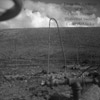
86-P-21-001
A point field. "In those years, the dredge ground was thawed with cold-water
points. Now the pressure that came down through the waterline and then eventually
was reduced into the hose that was attached to the cold-water point with a
3/4 inch pipe There was a diamond-shaped point with two jets that would come
out from either side. We would have what we called a clamp and a hammer. The
clamp doesn't show in this picture, but the clamp held on with a nut and we
carried a wrench. Each of us was assigned a number of points that we worked."
The crew worked 12 hours a day, connecting the points with 10-foot sections
of pipe. Working with hammer and clamp, these lengths were driven into the
ground, often 22-28 feet deep. "If I remember correctly, when we got
the points down it was something like 10 days we would leave them in and then
the points were pulled out and we would move on to another section of ground."
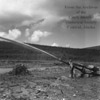
86-P-2l-002
Man working a giant. Water was pressurized to the giant from a ditch along
the hillside. It came down into the valley in pipes, starting at 4' diameter
and reduced so that you could get the pressure from the gravity of the water.
The giant was used to thaw and remove overburden and muck. As water reached
the giant, "they opened the nozzle with a small rod that the fellow that
was oprating the giant directed the water against the muck or overburden.
The idea was to get down to the gravel so that the dredge would be digging
thawed ground. As I recall, you would find gold 3 and 4 feet and on down to
bedrock." On the back end of the giant was a counter weight, or jockey
box, filled with rocks to balance. The overall length of giant and jockeybox
was around 12 feet. "But, if the fellow that. was running the giant,
after 12 hours or during the l2-hour span of standing there, would get mesmorized
by the water, it could get away from him. Then the giant would swing around
and, if he wasn't careful, it would knock him down and the water was pushing
him. It could cause someone to die."
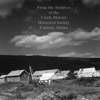
86-P-21-003
Camp buildings. "We haa two bunkhouses, housing 12 men each. We carried
about 27 people in the camp there. We had a few tents ',' The clothes line
, a 35 or 36 Ford pi ckup truck, and a drill rig are also shown. "The
drillers would drill across the valley there at Mammoth Creek where the dredge
was working or going to work so they would pretty well know what to expect
to recover. And another fact, the three drillers--Johnny Lake, Harold Christensen
(who became camp superintendent) and Harold Meyer, would pan drilled samples.
They rotated their shifts over 24 hours to see what they could expect the
dredge would recover from the amount of cubic yards of gravel that went through
the dredge.
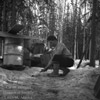
86-P-2l-004
Feeding a weasel at Grip's wood camp on Birch Hill, 3-5 miles east of Central.
May be camp visitor Hank Pagean.
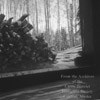
86-P-2l-005
Through the cabin window, the woodpile used to heat the wood-cutting cabin
at Birch Hill.
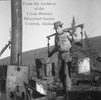
86-P-21-006
Lee Rebail carrying water, using a shoulder yoke, to the boilers. "We
were generating steam. WE WOULD thaw ahead of where the drill crew was going
to drill. Lee Rebail put his hat on first thing when dressed in the morning
ana the lst thing he took off at night when he got ready for bed was his hat.
He put it on top of his clothes ready to put on the first thing in the morning.
That was standard through the camp."
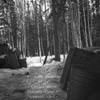
86-P-007
The Birch Hill wood camp yard, with weasel in left foreground.
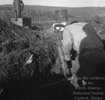
86-P-21-008
Lee Rebail using a hammer on the steam pipe where he is driving down so that
it is thawing ahead of the drill crew.
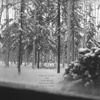
86-P-21-009
Winter wood camp. "We were paid $6 a cord and we tried to cut a cord
a day... we would take one day off, Sunday... in those days, we used a Swede
saw or box saw and on Sundays from 11 am. to 1:30, you would try to get your
saw filed because that was more or less twilight and the best time of day
you could see to file your saw."
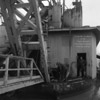
86-P-21-0l0
The superstructure of the dredge after the fire around 1938. It was a night
fire, apparently in August or early September.
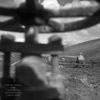
86-P-21-011
A closeup view of a big bell where we would cut off pressure on a certain
section of hydraulic pipe so that the points could be pulled. "You can
see a little in the foreground where the points are down quite low. A fellow
is sitting on one of the laterals and he has the point down low there."
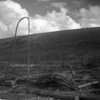
86-P-21-012
Here pipe are being pulled, preparatory to moving on to another section to
be thawed with water points.
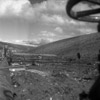
86-P-21-013
Another shot of point field, with dredge in distance. One of the point drivers
is walking a lateral section of pipe.
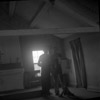
86-P-21-014
Mission at Circle City on July 4, miner's holiday. Chuck Gibson standing by
pulpit.
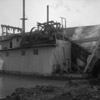
86-P-21-015
Sideview of dredge showing superstructure damage, after fire, 1938.
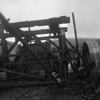
86-P-21-016
The charred timbers near the flywheel. The effects seems devastating, but
apparently was quickly repaired.
86-P-21-017
Long range view of man operating a giant.
86-P-21-018
Bucketline pretty well raised up. "I believe this shows, not too clear,
the lower tumbler. What we had done was snapped that shaft up and it just
snapped it off. So it was raised up and we are going to have to take the tumbler
off and get the shaft out to replace it."
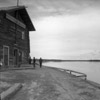
86-P-21-0l9
Circle City waterfront, July 4, during 1936-41 era. Building is original McQuesten
trading post building.
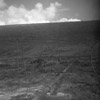
86-P-21-020
Point field, with point high, not yet driven down. "In the point field,
you always had to wear some type of boot, preferably a hip boot, because when
you sloshed through there, it could get pretty hectic unless you had some
good foot gear."
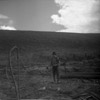
86-P-21-021
Member of the point crew in the point field.
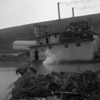
86-P-21-022
Another view of dredge after fire.
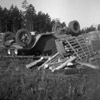
86-P-2l-023
View of overturned truck near Deer Park Recreation Area, outside Alaska.

86-P-2l-024
Inside view of dredge--appear to be water holding tanks.

86-P-2l-025
Silhouette of a "Cat" at mining camp.

86-P-2l-026
"Cat'! with dredge in background.

86-P-2l-027
Dredge, with camp in background. Bucketline is down and gangplank raised up.
"At the end of the gangplank, we have a little ladder and a rope hung
down so that when the dredge was digging quite deep and the gangplank would
get up pretty high off the ground or above the ground, you could pull down
this rope and pull the ladder down so that you could climb up the ladder and
walk down the gangplank and get on the deck."

86-P-2l-028
"Now here is a view I can hardly believe. It shows myself, Bill Grip,
pouring coffee and I can't believe it because I'm not a coffee drinker. And
this coffee pot is clean. Albert's (Kelzer, who kept coffee going on the dredge)
was so greasy and grimey you couldn't hardly believe how he could swallow
it. But he sure did. And it didn't hurt him, apparently."

86-P-2l-029
Closeup of the bucketline and the tumbler, and gangplank. Bucket lips are
pretty well worn down. "They get worn down and then they have to replace
them and rivet them. I understand years later they have improved so that it
was no trick to change the lip on a bucket. It doesn't show it, but I can
remember I did a little welding there and we had a good mechanic, Bill Zibell,
from Marysville, WA. He showed me some stuff. In those years, we used what
was called a studite rod. It was a hard rod , a hard surface rod, and it was
welded on. We would run the beads across that and it would reduce the bucket
wear, the lip wear where it was digging into hard, solid ground and running
against rock."

86-P-2l-030
"Now I believe this as a little rinky-dink plane. Actually we would ride
in these things." Ski/wheel plane, in Fairbanks.

86-P-2l-03l
Don Curlin and Art Wood, dressed up with neckties and suspenders. "I
think they are carving up a loaf of bread that Bill Gafford, the cook, made.
Art Wood was the flunky. Don Curlin was a wonderful singer, even without accompaniment
or music.

86-P-2l-032
Full view of bucketline. "Now these buckets on the Berry Dredge were
3 cubic foot buckets. And there were 63 of them on the line. You can see through
the gantry the winchman standing up there.

86-P-21-033
Cleanup! The riffle plates are up and you can see the sluicebox. Shows the
heavy construction of the dredge itself. "Incidentally, every ten days
we had a cleanup on the dredge. And the biggest cleanup we ever had, to my
knowledge, was a $32,000 cleanup. It was done in 1938. We hit particularly
good ground that year. 1550 ounces. Gold at that time was valued at $35 an
ounce, but the Berry gold was fine type, flour gold, and brought $27-28 an
ounce."
86-P-21-034
Long view of the dredge, with smoke from stacks and Old Glory flying. Shows
the stacker and sluicebox. Long cable stretching to the bow. The dredge had
two cables on each side "one in the bow and the stern on the port side...and
starboard side. I happened to be on the short crew, 6 p.m.-6 a.m. We were
the ones who did the "deadmen." A deadman was about an 8 foot log...spruce,
some 10-12 inches in diameter. And we had these cables, 3/4 inch rope cables,
if you will. And we would anchor the deadman and then we would put short,
possibly 5-6 foot, face logs these to slant at an angle so hopefully the winchman
wouldn't pull out our deadman. It was a disgrace when they would pull out
our deadman. Not only that, but I remember one time when a deadman was pulled
out, about 3 a.m., and Harold Christensen, our superintendent, came over and
woke us up to go out and dig that sucker back in so that they could continue
operations, because if the deadman pulled, the dredge wasn't going to go anywhere
until it was anchored again...if they were to break a cable for us, we would
put in a 28-foot running splice. I remember we had a pin and marlin spike
that we worked with. It was all hand done. We were proud when we made a good
splice."

86-P-21-035
"Must have been a warm day." Relaxing in tent after a 12-hour shift.
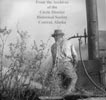
86-P-21-036
Steam flying, as Lee Rebail operates boiler.
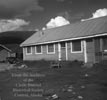
86-P-21-037
Sideview of cookshack. Where 3 windows line up, that is the eating area.
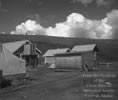
86-P-21-038
Another view of camp. Foreground building is ice house, with double-thick
walls about 18-24" thick, insulated with sawdust. In March, we cut ice
in big blocks from the dredge pond and hook a cable to the "cat."
We could drag the ice to the ice house to keep fresh meats well into summer.
Clear into July, the cook made ice cream for ub, "and if that wasn't
a treat for us out there at camp. Against the back of the cookhouse, we had
a big box-like tank mounted up quite high. That is where we kept the water
to keep the pressure for use when it came down into the use of the cook.
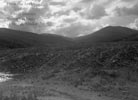
86-P-21-039
Overview of tailing piles.
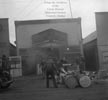
86-P-21-040
Fire at Fairbanks Paint Shop.
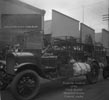
86-P-21-041
Fire at Fairbanks Paint Shop, showing the fire truck which the 1800 Fairbanks
citizens were proud of.

86-P-21-042
Drill rig--out of focus, but showing full rig.
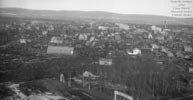
86-P-21-043
Coming into Fairbanks by air. Richardson Highway arch sign (1986: this sign
is at the Alaska Transportation Museum at Palmer) in center foreground. Federal
Building and NC Co. stack at center, left. FE company stacks (2) just below
the hills at center.

86-P-21-044
Chena River, in spring before breakup. "I know you call it the Chena
River, but to me, it is still the Chena Slough."
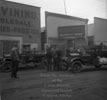
86-P-21-045
Firetrucks after paint shop fire in Fairbanks.

86-P-21-046
Hank Pagean, with his tripod and 21/4 x 31/4 Speed Graphic, standing atop
chicksale, door open.

86-P-21-047
Fire truck arrives steaming at Third Avenue, Fairbanks, fire at Fairbanks
Paint Shop.

86-P-21-048
Settling pond and tailing piles, in front of dredge.
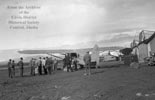
86-P-21-049
Miners preparing to head for Circle Hot Springs from Fairbanks by plane in
springtime.

86-P-21-050
Sluicebox on dredge. "You can see the riffle plate and the water coming
down there. And you can see far up where one of the fellows is in the process
of picking up one of the riffles and setting them aside.”